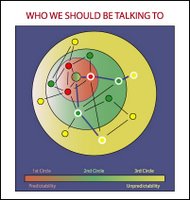
1 / Intracommunity assessment
People within communities work together to create a common understanding of the opportunity landscapes. We�re talking here about 5 types of communities:
a. people with needs/hopes
b. people with new ideas
c. people with talent/expertise
d. people with resources/funding
e. people with social/political/economic legitimizing power
At Level 1, people with needs and hopes work together with other people with needs and hopes; people with new ideas work together with other people with new ideas, and so on. All collaborations happen within each community.
2 / Intercommunity assessment
People across communities work together to create a common understanding of the opportunity landscapes. For example at Level 2, you find collaborations between people with needs/hopes working with people with new ideas. People with funding/resources working with people with talent/
3 / Intracommunity dreaming
People within communities collaborate in visioning, prioritizing, and planning relative to discovered collaboration opportunities.
expertise.
4 / Intercommunity dreaming
People across communities collaborate in visioning, prioritizing, and planning relative to discovered collaboration opportunities.
5 / Select-invite R&D project
People within or across communities work together in invitation-specific projects
6 / Open R&D project
People within or across communities work together in open invitation projects
7 / Shared ownership/governance of new enterprise
Participants of R&D projects that create a new enterprise share ownership and/or governance. New enterprises include new civic programs, organizations, services.
 RSS Feed
RSS Feed Twitter
Twitter
